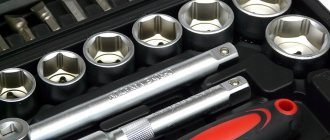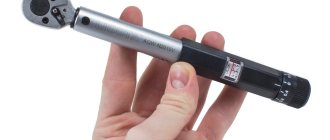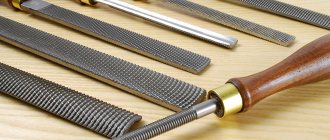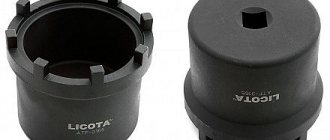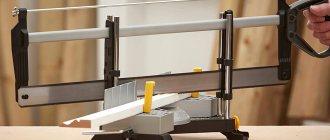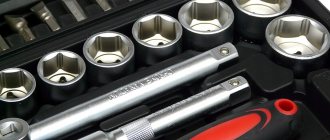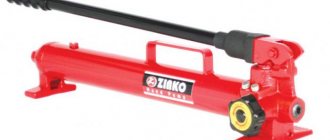Standard sizes of open-end wrenches
Any tool has its own characteristics and parameters. There are also generally accepted standard sizes of open-end wrenches. To determine the size , you need to pay attention to the span of the part that its motionless jaws have. This is the so-called throat of the instrument. The handle of any open-end wrench has a digital marking. This is the size in millimeters that determines the width between the jaws.
Standard sizes can range from minimum (2.5x3.2 mm) to maximum (70x80 mm).
These are acceptable GOST standards that cannot be violated under any circumstances. GOST also specifies other characteristics of open-end wrenches, for example:
- A special calculation of the maximum deviations of the pharynx size is carried out;
- Any manufactured open-end wrench must have specified strength and hardness;
- The trademark marking is established;
- The decorative and protective coating of the key, etc. is taken into account.
Types of keys
Now let's look at what varieties there are.
The most commonly used wrenches have two jaws. Another name for it is a double open-end wrench (GOST 2839). If you need to unscrew a fastener with a mag of 18 or 20 mm between opposite edges, then you need to choose a tool with a handle on which the designations 18 and 20 are located. It happens that in force majeure circumstances a tool of the required size is not always at hand. In this case, a key one size larger is suitable . When using a tool that is not suitable for its intended purpose, you need to use a knife or screwdriver, install them in an empty space.
Types of horn instruments:
- composite (GOST 16.983). Their design contains an end structure nozzle, a hollow socket and a handle, short or long;
- adjustable (GOST 7275.75). These are open-end wrenches where the size can vary;
- narrow profile keys. These are specific keys for a certain type of activity;
- There are star, Bristol and hex keys (GOST 11737.93) that are used to work with bicycle and computer equipment, with screwing in fasteners in hard-to-reach places that border almost on jewelry work.
Materials for production
According to existing requirements, wrenches must be manufactured using tool steel, an alloy of chromium and vanadium or similar. It must be solid material. The information is reflected in the labeling.
Imported tools contain the following designations: Cr (chrome steel), CrV (chrome vanadium alloy), CrM (chrome molybdenum alloy), CrMoV (chrome molybdenum vanadium steel), etc. GOST recommends that domestic manufacturers prefer chromium-containing steel grade 40X with good strength for the manufacture of open-end wrenches . Usually this is enough for the majority of actions with keys. For high-strength products, chrome vanadium alloy 40 HFA is used. The best instruments are made from grade 45 metal.
Chinese and unidentified keys are sometimes labeled Drop Forget Steel. These accessories are made by forging from unalloyed steel, which means they are fragile and will fail at the wrong time.
How to choose an open-end wrench?
How to choose the right tool so that it meets all GOST standards? The variety of models shows that there are different types of products for every need. You need to consider the purpose of its use and the complexity of the task you set for it. The material used for the production of modern nut products is special tool steel ; it consists of an alloy of vanadium and chromium.
There is also one unique tool that will help solve all problems at once, and eliminate the need to think about which open-end wrench to choose.
There are universal models that contain all products at the same time. This tool can handle nuts of various sizes with all types of heads.
It does not slip on a smooth surface due to its powerful teeth, which is its main advantage. There are also electric keys, the name speaks for itself. This tool can be powered by battery or batteries. Therefore, each home craftsman himself determines which products are best suited for him.
The price category is quite varied. Most often, the price depends on the versatility of the technical characteristics and the manufacturer. The cheapest is a single-sided horn instrument, where the open mouth has 3.1–85 millimeters.
When purchasing, you also need to remember about the long handle , which can limit the amplitude of movement of the key when turning. If one of the jaws is shortened, then, naturally, the radius of the wrench increases. In this case, you will be able to place the head on the side of the nut. If the handle is artificially enlarged, the applied force increases, and the jaw jaws will separate or even break. A hammer will be able to help set them in place when spreading, but the material will not be as strong as before. When you have a product made of 40xFA or 40x steel, then there is a method of hardening the sponge.
There is another option on how to repair a broken or worn out pharynx.
By welding the metal layer, you can adjust the volume of the throat using an abrasive tool.
When the open gap is more than 25 mm, then this option for restoring the product will be the most effective. The service life of carob products can range from a year to five. When talking about durability, they always mean a ring wrench (GOST 2906). It cannot be crushed, but it can wear out. There are restrictions on the use of this type of key. It can only be used if it is put on the nuts, but it cannot be used to unscrew, for example, union bolts of flexible hoses. The advantage is the hexagonal or twelve-sided jaw, which makes it possible to carry out work more intensively.
What is a socket wrench?
This is a device for unscrewing that is put on the nut from the end (top). By analogy with the carob, it has a double-sided design. However, a socket wrench is a tool that comes in a variety of modifications. You can find angular, tubular, hinged, a version in the form of cap heads and other models. The socket wrench is in high demand among motorists. Only they can unscrew spark plugs or securely fasten wheels. A socket wrench, compared to others, has the advantage of a larger surface of contact with the object to be unscrewed.
What does a socket wrench look like?
This is a piece of a metal cylinder, in the inner cavity of which a hexagonal hole is made in various ways. The hexagon size corresponds to the nut being unscrewed. There are models with twelve faces. For special cases (for example, working with shut-off valves), a tetrahedral or triangular socket wrench is available. The cylinder is connected to a lever, which is used to rotate the tool. In the case of the version with removable heads, there is a separate rotating rod with a square or round slot. It can be equipped with a ratchet.
Keys have different protective coatings. The black color of the instrument comes from oxidation in oil. The white matte color is obtained by galvanic application of zinc compounds. The shiny surface of the key is obtained by chrome plating. A socket wrench can be produced with expensive anti-corrosion protection - this is a coating with a special composition followed by polishing.
Composite kits
Such accessories, which facilitate work and access to difficult and narrow places, consist of several parts. For example, a tubular wrench is equipped with a wrench, and a set of sockets has a ratchet. All these are models of the covered type: their body is covered by a fastening element. There are other tools too. In terms of their method of operation, they are similar to a screwdriver, i.e. they are inserted into a slotted channel in the same way. An example is a hexagon.
Read also: Do-it-yourself machine for cutting plastic bottles
Basic requirements for tools
For a quality device there are a number of requirements:
- the surface of the instruments is smooth, with anti-corrosion treatment, there are no cracks or kinks on it; parallel jaws without distortions;
- working profile without chips, hardening, or other mechanical damage;
- combination and ring wrenches have uniform ring sizes and a strictly central location of the holes;
- the existing rotation toggle switch is firmly fixed in the ratchet;
- All markings are applied and readable.
The working profile of tools means a combination of planes that impart mechanical pressure from a locksmith tool to the element that needs to be unscrewed.
The body of the wrench is the body of the product that transmits the mechanical effect. Individual characteristics characterize a particular object.
For open-end wrenches, GOST strictly regulates the standard size. It is determined by the gap cavity between the jaws - the mouth of the key. This parameter is measured in millimeters and is recorded in special reference tables. Markings are applied to the body. In the description of such wrenches, GOST requires an indication of the size, hardness, and surface coating material. There is a wide range of key sizes: the minimum is 2.5 millimeters, the largest is 75 mm. Number systems.
Read also: Five-pin relay DRL connection diagram
One of the characteristics also concerns the size of the tool. Some world manufacturers, on a German initiative, show data on indicators of working elements based on the European (metric) structure. Many others use US inch. The conflict between the systems manifested itself in the coincidence of only two dimensions - 15 mm (19/32′′) and 19 mm (¾′′).
Depending on the calculation system, accessories are divided into two categories:
- Those that support the metric system. The size is given in millimeters and varies between 2.5-230 mm for general kits, 6-41 mm for automotive ones.
- Inch tools work in a system with the main measure inch (1′′ = 25.4 mm). Dimensions range from 1/8 to 91/8′′. For car open-end wrenches, GOST sizes range from 1/8 to 15/8′′.
Mass types of keys
Touching on the topic of wrenches, an unforgettable image of an open-end wrench appears before your eyes. The nuts are fixed using lips that look like horns. This is where the name comes from. The second name for such means is used by GOST - open-jaw wrench. The center lines of the handle and head most often intersect at an angle of 15-20 degrees. When manipulating in tight spaces, this configuration will make the work easier. The angles between the axes of the head and handle are made in different sizes; opposite heads have different slopes from each other. Horn models are typically divided into various modifications:
- Double-sided instruments have two jaws of different dimensions. Usually their size designations are adjacent (18−19 mm). The jaws can have different thicknesses: thin ones work in hard-to-reach places, while thick ones are used for loosening nuts made of soft materials.
- For one-sided ones, the body is lengthened in order to increase the moment of force when interacting with fasteners. It is used in assembly production for operations with the same type of nuts. Some models have a locking shank for tube extensions.
- High-speed with a modernized working profile and a shortened jaw for high-speed movement of the key from one element to another. The rotation changes when the tool is turned one hundred and eighty degrees.
- Profile cuts on the lips of open-end wrenches increase the number of contact points and shift the location of the boundaries of the fastening components relative to the jaw. The turning force does not damage the structure in the planes of the nut or in the heads of the bolts, and allows you to unscrew deformed elements.
- A wrench with a working profile in the form of a ring, which is put on the mounting surface, is called a spanner. They can have rings at both ends of the working plane. There are edges along the inner diameter. There are six or twelve of them. The hex power tool unscrews tight, soured connections easily and without damage. Twelve-sided is used when working space is limited. The working profile can be made elongated for the use of attachments. The undoubted advantage of the attachment tool is the permissibility of exerting a large force on the unscrewing planes and working in cramped areas. The weak point is discomfort when working with threads of increased length.
- Devices that have a horn-type head on one end and a cap or end-type head on the other are classified as combined. Their heads are the same size on both sides. The dimensions of the body length are different: when space is limited - shortened standard increasing forces - elongated ones creating the maximum peak of pressure - extra long.
- A tool with a variable working profile is called an adjustable tool. The transformation occurs due to a screw mechanism or slider, which moves the moving part to the required width. The clamping of the fixing parts is not tight, which leads to the rolling of the edges. A plus is the possibility of using it with nuts of various diameters.
Double-ended open spanners. Constraction and dimensions
Normative references
- GOST 4543-71 Rolled alloy structural steel. Technical conditions. Replaced by GOST 4543-2016.
- GOST 2838-80 Wrenches. General technical conditions
For free
download this document in PDF format, support our site and click the button:
GOST 2838-80 (ST SEV 1285-78); GOST 2839-80 (ST SEV 1287-84); GOST 2841-80 (ST SEV 1286-84); GOST 2906-80 (ST SEV 1292-84);
USSR STATE COMMITTEE ON STANDARDS
APPENDIX 2 Recommended
WRENCH HANDLE DIMENSIONS
Maximum deviations of dimensions, except S and I - according to normal accuracy GOST 7505-74.
(Changed edition, Amendment No. 2).
UDC 621.883:006.354 Group G24
STATE STANDARD OF THE USSR UNION
DOUBLE-SIDED OPEN-END WRENCHES
Design and dimensions
Double-ended open spanners. Construction and dimensions
By Decree of the USSR State Committee on Standards dated June 16, 1980 No. 2800, the validity period was established
from 01/01/81 to 01/01/91
Failure to comply with the standard is punishable by law
1. This standard applies to open-end wrenches with dimensions from 2.5x3.2 to 75x80 mm, manufactured for the needs of the national economy and for export.
2. The main dimensions of the keys must correspond to those indicated in the drawing and in the table. 1.
Dimensions of SiXS2 sheds
Continuation of the table. I
Dimensions of SiXS2
(prev, off by h 15)
Continuation of the table. I
Note. The sizes of the pharynx along the 1st row are preferred for use.
An example of a symbol for a wrench with jaw dimensions of 17X19 mm, increased accuracy P, strength group C, with surface roughness version 1 according to GOST 2838-80, with a chrome coating 9 microns thick:
Key 7811-0023 P S 1 X9 GOST 2839-80 The same, normal accuracy:
Key 7811-0023 C 1 X 9GOST 2839-80 (Changed edition, Amendment No. 2).
3. Keys must be made of strength groups C and D according to GOST 2838-80 from the steel grades indicated in table. 2.
It is allowed to use steel of other grades with mechanical properties in a heat-treated state not lower than those of the steel grades indicated in the table. 2.
A simple wrench is a common tool for manipulating bolts and nuts. Over a long period of existence, a huge number of varieties of such devices have been invented. It is difficult to list all types of basic and special models. Among such assistants, the open-end wrench occupies a special place with its advantages and disadvantages.
Table of contents
Appendix 1 (recommended) Wrench head sizes
Appendix 2 (recommended) Wrench handle dimensions
×
| Date of introduction: | 01.01.1981 |
| Added to the database: | 01.09.2013 |
| Update: | 01.01.2019 |
This GOST is located in:
- Section: Ecology
- Subsection: 25 MECHANICAL ENGINEERING
- Subsection: 25.140 Hand tools
- Subsection: 25.140.30 Manually operated instruments
- Section: Electricity
- Subsection: 25 MECHANICAL ENGINEERING
- Subsection: 25.140 Hand tools
- Subsection: 25.140.30 Manually operated instruments
Ratchet wrench
Some models of end and cap type are equipped with a ratchet mechanism (ratchet). An added advantage is the ability to throw the tool. And the small angle required for turning makes screwing and unscrewing the nuts much easier. Ratchet designs vary in the number and size of teeth. To rotate a tool with 72 teeth, 5° is enough, 40 teeth - 9° .
This is very helpful in cramped working conditions. It has one drawback - the ratchet often breaks due to excessive load. Such a tool is much more expensive.
Socket wrench heads
A convenient option for using this type of tool. If we compare a set of socket wrenches and replacement heads, the latter occupy a more advantageous position due to their compactness and lower weight of the set. A wrench is included with the removable hexagons. It can be equipped with a ratchet that can be adjusted to move in one direction only. Sets of socket heads can be supplied in two versions: with a hole in the side walls and with an internal tetrahedron at the end of the heads.
The driver in the first case is a simple metal rod with the appropriate diameter. In the second version, it has a square end with a locking ball. A swivel joint and an extension rod are provided. A set of interchangeable heads can replace a universal hexagon socket wrench. This is the only head with a set of spring-loaded metal pins inside. The rods are able to move freely. Deepening, they cover a nut of any size and fix it when unscrewing or tightening.
Specific equipment options
Other options include a spoke tool and a bicycle wrench , which many may be familiar with from childhood. The variant of the colic mounting tool is interesting in that its second end is a tapering rod. There are nut breakers that are used to remove stuck nuts. If the nut is not hexagonal, but round, and we must remember that this also happens, then you need to use a special tool for screwing or unscrewing it. The pipe mechanism is popular among plumbers, and special chain wrenches are used for round parts with a large diameter.
How to use a socket wrench?
A few tips will help you unscrew any nut and keep the tool safe for a long time:
- It is recommended to use socket wrenches with replaceable heads (or any other) strictly of the same size as the object being unscrewed. If the tool size is larger, then it is possible to round the edges of the nut or bolt head. This will make it difficult to unscrew further.
- If such a problem occurs, you can use a file to remove part of the metal from the side edges to the next lower key number. It is important to monitor the dimensions between the edges. The tighter the connection to the key head, the more likely success is.
- Before unscrewing, you need to make sure that the nut is not stuck. To do this, you need to try to turn it without applying excessive force. Otherwise, the thread or nut may be damaged.
- If this cannot be done, it is recommended to lubricate the nut with penetrating lubricant or wet it with kerosene and let it stand for a while. Lightly tapping the threaded connection promotes unscrewing.
- To increase the unscrewing force, it is necessary to use an extended lever. The larger the arm from the point of application of force to the axis of rotation, the higher the torque.
- When using removable heads or extensions, you must ensure that these attachments are firmly seated in their sockets. To do this, you need to insert them until the latch clicks.
- When a socket wrench with a ratchet is in use, then you need to set the shift lever to the correct position. Otherwise, when unscrewing, the mechanism will tend to tighten the threaded connection and vice versa.
